
The Indo-Aryan languages are a branch of the Indo-Iranian languages in the Indo-European language family. As of the early 21st century, they have more than 800 million speakers, primarily concentrated in India, Pakistan, Sri Lanka, Bangladesh, Nepal and Maldives. Moreover, apart from the Indian subcontinent, large immigrant and expatriate Indo-Aryan–speaking communities live in Northwestern Europe, Western Asia, North America, the Caribbean, Southeast Africa, Polynesia and Australia, along with several million speakers of Romani languages primarily concentrated in Southeastern Europe. There are over 200 known Indo-Aryan languages.
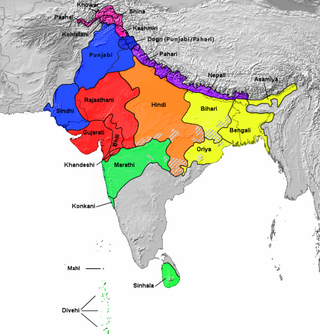
The Northern Indo-Aryan languages, also known as Pahāṛi languages, are a proposed group of Indo-Aryan languages spoken in the lower ranges of the Himalayas, from Nepal in the east, through the Indian states of Jammu and Kashmir, Uttarakhand, Himachal Pradesh and Punjab(not to be confused with the various other languages with that name) was coined by G. A. Grierson.

The Hindi Belt, also known as the Hindi Heartland, is a linguistic region encompassing parts of northern, central and eastern India where various Northern, Western, Eastern and Central Indo-Aryan languages subsumed under the term 'Hindi' are spoken. The term “Hindi belt” is sometimes also used to refer to the nine Indian states whose official language is Modern Standard Hindi, namely Bihar, Chhattisgarh, Haryana, Himachal Pradesh, Jharkhand, Madhya Pradesh, Rajasthan, Uttar Pradesh and Uttarakhand, as well as to the union territory of Chandigarh and the National Capital Territory of Delhi. It is also sometimes broadly referred to as the Hindi–Urdu Belt or Hindustani Belt.
The Western Pahari languages are a group of Northern Indo-Aryan languages spoken in Northern India, primarily in the state of Himachal Pradesh and Jammu.

Kumaoni is an Indo-Aryan language spoken by over two million people of the Kumaon region of the state of Uttarakhand in northern India and parts of Doti region in Western Nepal. As per 1961 survey there were 1,030,254 Kumaoni speakers in India. The number of speakers increased to 2.2 million in 2011.

Kangri is an Indo-Aryan language spoken in northern India, predominantly in the Kangra, Una and Hamirpur of Himachal Pradesh as well as in some parts of Mandi and Chamba districts of Himachal Pradesh and Gurdaspur, Rupnagar and Hoshiarpur districts of Punjab. Kangri language is also spoken in Duggar i.e. Jammu region and in a few villages of Pakistan by the people belonging to the families migrated from Kangra Valley. It is associated with the people of the Kangra Valley. The total number of speakers has been estimated at 1.1 million as of 2011.
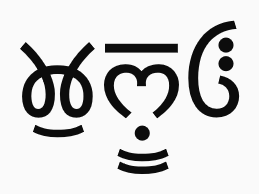
Kullui is a Western Pahari language spoken in the Kullu District of the Indian state of Himachal Pradesh.

Mandeali is a language spoken in northern India, predominantly in the Mandi district of Himachal Pradesh by the people of the Mandi Valley and particularly in the major city of Mandi. Other spellings for the name are Mandiyali and Mandiali. UNESCO reports it is one of the highly endangered languages of India. Speakers of the dialect have decreased by 21% from 1961 to 2001.
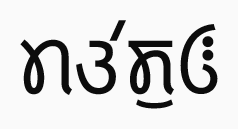
Mahasu Pahari is a Western Pahari language spoken in Himachal Pradesh. It is also known as Mahasui or Mahasuvi. The speaking population is about 1,000,000 (2001). It is more commonly spoken in the Himachal Pradesh, Shimla (Simla) and Solan districts. It is to be known that Shimla and Solan were parts of the old Mahasu district. Himachal Pradesh State on 1 September, 1972 reorganised the districts dissolving Mahasu district. The Solan district was carved out of Solan and Arki tehsils of the then Mahasu district and tehsils of Kandaghat and Nalagarh of the then Shimla District of Punjab.

Sirmauri is a Western Pahari language spoken in the Sirmaur district in the northern Indian state of Himachal Pradesh. Its two main varieties are Dharthi and Giripari.

Jaunsari is a Western Pahari language of northern India spoken by the Jaunsari people in the Chakrata and Kalsi blocks of Dehradun district in the Garhwal region of Uttarakhand state.

Pahari Kinnauri, or Kinnauri Pahari, also known as Oras Boli, is a Western Pahari of northern India. It is spoken by different tribal groups in Kinnaur District; the language used to be commonly known as ‘Kinnauri Tribal language’, but this is now considered a derogatory term. It is not clear how distinct it is from other varieties of Himachali.
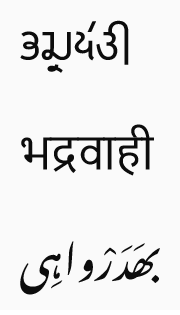
Bhadarwahi is an Indo-Aryan language of the Western Pahari group spoken in the Bhaderwah region of Indian administered Jammu and Kashmir.
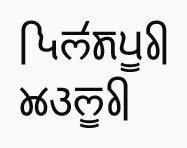
Bilaspuri, or Kahluri (Takri:𑚊𑚩𑚥𑚱𑚤𑚯) is a language spoken in northern India, predominantly in the Bilaspur district of Himachal Pradesh. It is associated with the people of the former princely state of Bilaspur in the Panjab Hills.

Kishtwari or Kashtwari is a northern Indo-Aryan language closely related to the Kashmiri language, with strong influences from neighboring Western Pahari varieties, spoken in the Kishtwar district of Jammu and Kashmir, India.

Sarazi or Sirazi is an Indo-Aryan language spoken in the Saraz region of the Jammu division of Jammu and Kashmir, India. It is native to the Saraz region, a hilly area taking up the northern half of Doda district and parts of neighbouring Ramban and Kishtwar districts. Sarazi is spoken as a first language by 46,000 people, primarily Hindus, but it is also used as a lingua franca of the Saraz region and so is also spoken as a second language by Muslims, most of whom are native speakers of Kashmiri. Sarazi has similarities both to Kashmiri, and to neighbouring Western Pahari languages like Bhaderwahi, though it is nowadays most often classified with the latter. Various local names for the language, which may represent distinct dialects, include Bhagwali, Deswali, and Korarwali. Sarazi is not often used in writing, but when written, the default choice for a script falls on Perso-Arabic. The Latin script is also common, whereas Devanagari and the historical Takri script are encountered occasionally.
Chambeali is a language spoken in the Chamba district of Himachal Pradesh.

Pangwali is a Western Pahari language of Himachal Pradesh, India. It is spoken in the Pangi Tehsil of Chamba district, and is threatened to go extinct. Pangwali is natively written in the Takri script, but Devanagari is used as well. It is very similar to the Padderi language of Padder, J&K.

Churahi is a Western Pahari language of Himachal Pradesh, India. It is spoken in the Chaurah and Saluni tehsils of Chamba district, and is considered vulnerable.

Gaddi is an Indo-Aryan language of India. It is spoken by the Gaddi people primarily in Bharmour Tehsil of Chamba district in Himachal Pradesh. It is also spoken in neighbouring parts of Jammu, with Gaddi villages found in Udhampur, Kathua and Doda districts.



















